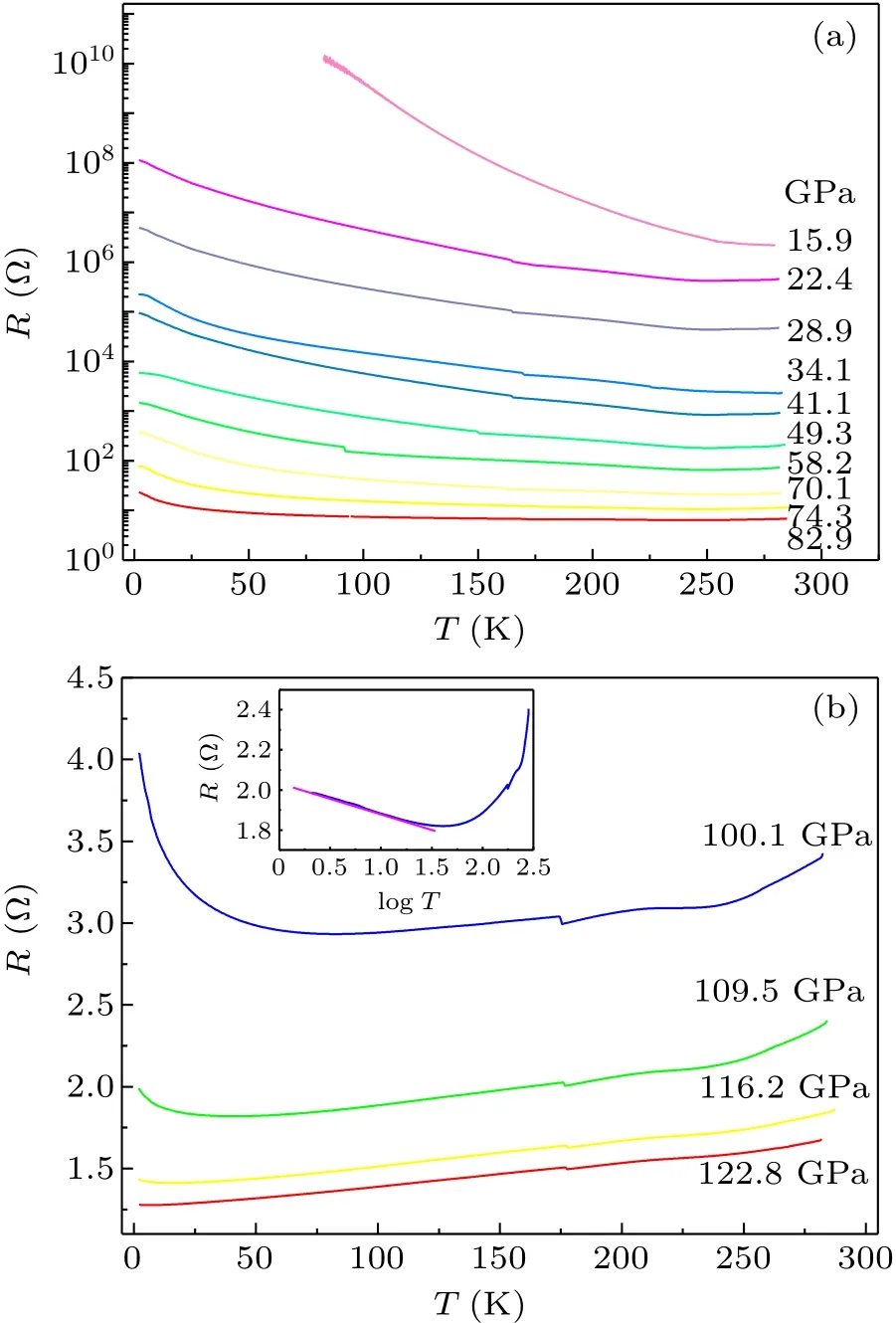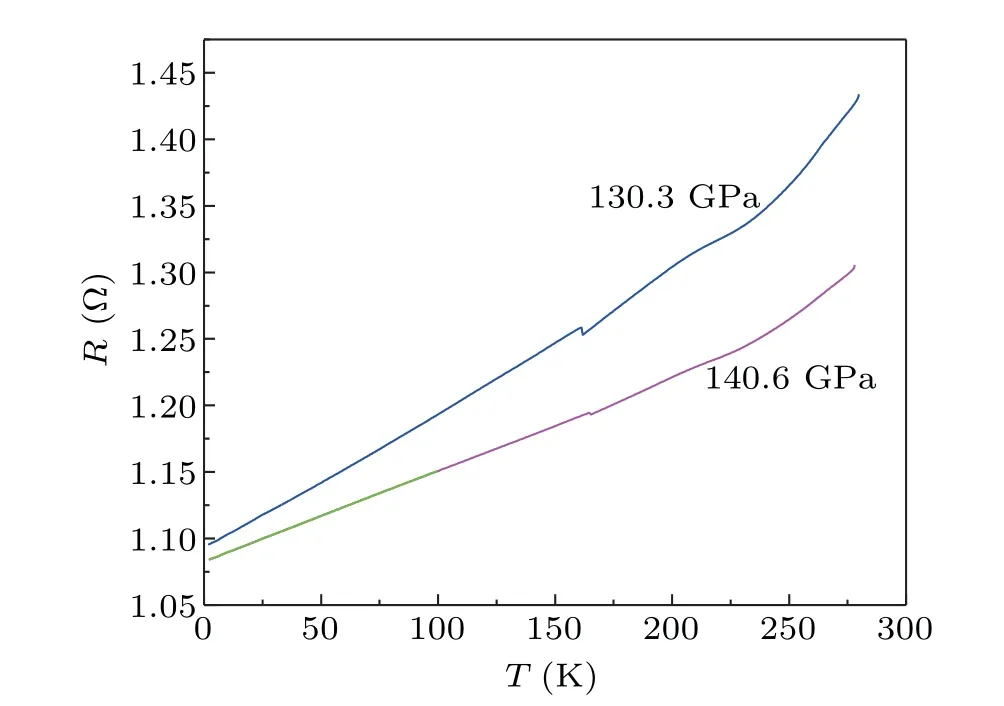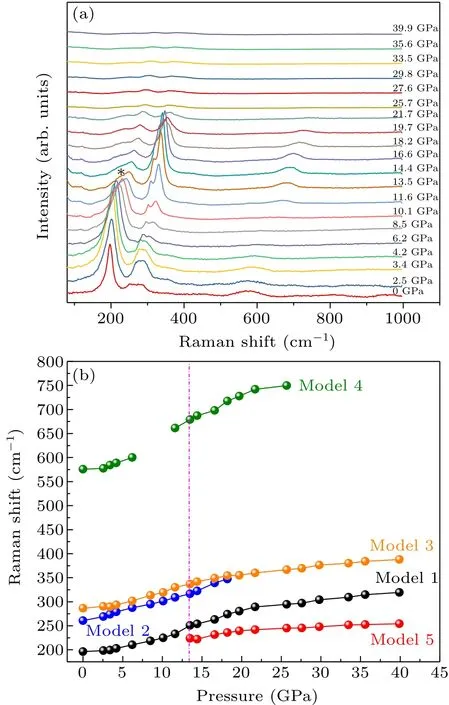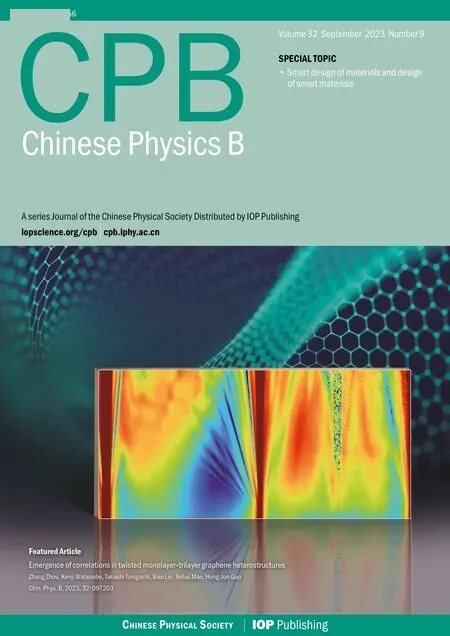Pressure induced insulator to metal transition in quantum spin liquid candidate NaYbS2
Yating Jia(賈雅婷), Chunsheng Gong(龔春生), Zhiwen Li(李芷文), Yixuan Liu(劉以軒), Jianfa Zhao(趙建發(fā)),Zhe Wang(王哲), Hechang Lei(雷和暢),?, Runze Yu(于潤(rùn)澤), and Changqing Jin(靳常青),6,?
1Institute of Physics,Chinese Academy of Sciences,Beijing 100190,China
2Xi’an Modern Chemistry Research Institute,Xi’an 710065,China
3Laboratory for Neutron Scattering,and Beijing Key Laboratory of Optoelectronic Functional Materials MicroNano Devices,Department of Physics,Renmin University of China,Beijing 100872,China
4College of Chemistry and Material Science,Hebei Normal University,Shijiazhuang 050024,China
5Center for High-Pressure Science and Technology Advanced Research,Beijing 100094,China
6University of Chinese Academy of Sciences,Beijing 100190,China
Keywords: high pressure,quantum spin liquid,insulator to metal transition,NaYbS2
1.Introduction
Quantum spin liquid(QSL)is an exotic quantum ground state in condensate matter physics, which shows no longrange magnetic order even at absolute zero temperature due to the strong quantum fluctuation.[1–3]The features of longrange quantum entanglement and fractionalized excitations for quantum spin liquid have great potential applications in quantum communication and quantum computation.[2]More importantly, P.W.Anderson proposed that quantum spin liquid is the ground state of high temperature superconductivity(HTSC), and superconductivity could be realized through insulator to metal transition(MIT)of QSL.[4]Thus,tremendous efforts have been devoted to investigating the Mott transition of QSL.[5–8]However,most of the attempts failed owing to the high energy gap or the difficulty of inducing enough charge carriers doping in the inorganic quantum spin liquid system.
Recently we observed pressure induced MIT followed by the appearance of superconductivity in the inorganic quantum spin liquid candidate NaYbSe2.[9]NaYbSe2belongs to the NaLnCh2(Ln=rare earth,Ch=O,S,Se)system,which has been proposed to be a promising candidate to realize QSL state.[10–14]Around these compounds,NaYbSe2possesses the smallest energy gap (1.9 eV), showing great potential to be a metallic state under pressure.This is the first observation of the Mott transition and superconductivity in an inorganic quantum spin liquid system,and can avoid the mess of disorder like that in organic QSL and makes it a good choice to investigate the intrinsic properties of QSL.Recently,Yanget al.explored the underlying mechanism of the insulator-to-metal transition and superconductivity of NaYbSe2and established an overall picture of its electronic phases under pressure utilizing density functional theory and the dynamical mean-field theory.[15]They found the superconductivity emerged in the heavy fermion phase with well-nested Yb-4f Fermi surfaces,suggesting that spin fluctuations may play a role in the Cooper pairing.Moreover, they pointed out that NaYbSe2might be the third Yb-based heavy-fermion superconductor with a very highTcthan most heavy fermion superconductors.
NaYbS2is isostructural to NaYbSe2, and possesses the second smallest energy gap (2.7 eV) in this NaLnCh2(Ln=rare earth,Ch=O, S, Se) series compounds.[11]To have a deep insight into the intrinsic physics properties of this series of compounds especially the Mott transition and superconductivity, in this paper, we systematically investigate the highpressure transport properties of NaYbS2single crystal and the crystal structure evolution up to 150 GPa.
2.Experiment
NaYbS2single crystals were grown by flux method.The Yb powder,S powder and NaCl grain(as flux and Na source)were mixed together with the molar ratio of 2:3:10 and loaded into a silica tube and then sealed under Ar atmosphere (~0.2 atm).The sealed tube was heated to 900°C–950°C for 24 h and kept at that temperature for 150 h,and cooled down to room temperature.Finally,the single crystals were got after washing NaCl flux using distilled water several times.[11]
Transport properties of NaYbS2under high pressure and low temperatures were measured through Van der Pauw method using a diamond anvil cell (DAC) made of CuBe alloy.[16–19]A pair of diamonds with a 100 μm diameter culet were used to generate pressure.A T301 stainless steel gasket was pressed from a thickness of 250 μm to 20 μm,and drilled a center hole with a diameter of 300 μm.The gasket was covered by cubic boron nitride(cBN)powder to protect the electrode leads insulated from the metallic gasket.The sample chamber was a 100 μm-diameter center hole in the insulating layer and the pressure transmitting medium was NaCl powder.The sample size was about 40 μm×40 μm×5 μm.The electrodes were slim Au wires with a diameter of 18 μm.The pressure was measured via the ruby fluorescence[20]and Raman spectra of the diamond anvil were adopted to calibrate pressure for the experiments above 100 GPa.The diamond anvil cell with samples and electrodes was loaded inside a cooled cryostat system to perform the experiments.A thermometer was mounted near the diamond in the diamond anvil cell to monitor the exact sample temperature.Raman spectra measurement was performed using the Renishaw micro-Raman spectrometer with a symmetric Mao–Bell DAC at room temperature.The wavelength of laser was 532 nm.
3.Results and discussion
Figure 1 shows the temperature dependence of resistance of NaYbS2single crystals in theab-plane.It can be seen clearly that below 15.9 GPa,the sample shows a very high insulating property, even out of the range of the measurement.Under higher pressure, the resistance decreases quickly but still keeps an insulting state below 82.9 GPa.The absolute values of resistance at room temperature decrease with increasing pressure dramatically by more than six orders of magnitude.This behavior is similar to that NaYbSe2, but with a much smaller rate.The decreasing rate for NaYbSe2is about 0.3 orders of magnitude per GPa, while the corresponding value for NaYbS2is about 0.12.This result indicates that NaYbS2shows more insulting behavior than that NaYbSe2, which is coincided with the truth that energy gap of NaYbS2(2.7 eV)is larger than that NaYbSe2(1.9 eV).Under further compression, a metallic state emerges at 100.1 GPa, but with a minimum resistance at about 80 K(namedTmin).The temperature for theTminmoves to a lower temperature and finally almost disappears at about 122.8 GPa.The upturn behavior of resistance belowTminobeys the rules of logarithmic temperature dependence and is recognized as a weak localization area as that in NaYbSe2.[9]Yanget al.’DFT calculation indicated that the resistance should be dominated by incoherent Kondo scattering.[15]Here,we find both NaYbS2and NaYbSe2show similar behavior,suggesting that it may be the intrinsic physical property related to the 4f electron.

Fig.1.Pressure effect on the resistance of NaYbS2.(a)Temperature dependent resistance for NaYbS2 single crystal in insulating state up to 82.9 GPa.(b)Temperature dependence of resistance of NaYbS2 single crystal between 100.1 GPa and 122.8 GPa.The inset shows the resistance vs.log T data at 109.5 GPa,showing a linear behavior below Tmin (see magenta line).
The piezochromism of the NaYbS2single crystal also coincides with that transport properties,reflecting the narrowing of the band gap.The color of NaYbS2single crystal is light blue at 3.1 GPa, which is coincided with the result reported in previous work.[11]It becomes deep blue at about 22.4 GPa,and then becomes red at 41.4 GPa.When the pressure was enhanced up to 58.2 GPa,there is only a small amount of red color can be seen,indicating the gradual decrease of band gap.The sample becomes completely dark when pressure is above 74.3 GPa.However, the sample is still in an insulating state,indicating the band gap is very small but still not completely closed.
NaYbS2single crystal becomes completely metallic at about 130.3 GPa (see Fig.3).Moreover, it is noted that the metallic state at low temperature range shows a nearly linear behavior,indicating a non-Fermi liquid behavior.We have applied the power-law fittingR(T)=R0+ATnto the resistance of NaYbS2at 130.3 GPa and 140.6 GPa,respectively.The orange line in Fig.3 shows the fitting result ofR(T)between 8 K and 100 K at 140.6 GPa.It can be seen that the power-law formula fits the experimental data well in this temperature range.The pressure dependence of the exponentnis about 1.01 and 0.98 respectively,clearly indicating a non-Fermi liquid behavior,and it is also similar to NaYbSe2.However,superconductivity is absent in the whole pressure range of our experiment.We believe it may need higher pressure to drive a non-Fermi liquid behavior to Fermi liquid one and finally the emergence of superconductivity.
Next,we focus on the structural evolution of NaYbS2under pressure.Pressure dependent Raman spectra for NaYbS2single crystal are shown in Fig.4.There are four obvious vibration modes at around 196 cm-1,260 cm-1,286 cm-1and 576 cm-1, assigned as modes 1, 2, 3 and 4, respectively.We use the Gaussian function to fit the peak position of the Raman spectrum.It can be seen clearly that with the increase of pressure the Raman vibration modes shift to the high frequency(Fig.4(a)), indicating the contraction of sample.There is a new vibration mode that appeared at 13.5 GPa at 224 cm-1(see asterisk in Fig.4(a), assigned as mode 5), signifying the phase transition occurring(see Fig.4(b)).The transition pressure (13.5 GPa) is higher than that NaYbSe2(11 GPa).The details of crystal structure evolution still need to be further investigated using the high-pressure x-ray diffraction.

Fig.3.Temperature dependence of R(T)for NaYbS2 single crystal in metallic state at 130.3 GPa and 140.6 GPa.The green line demonstrates the experimental fitting results of R(T) below 100 K at P=130.6 GPa using the formula R(T)=R0+ATn.

Fig.4.(a) Raman spectrum at selected pressures at room temperature for NaYbS2.The asterisk indicates a new vibration mode.(b) Evolutions of Raman vibration modes as functions of pressures for NaYbS2.
From the above results, it can be clearly seen that both NaYbSe2and NaYbS2show similar behaviors, including the MIT, minimum of resistance and non-Fermi liquid behavior at high pressure region, suggesting they might be universal for NaLnCh2system at high pressure and low temperature region.Moreover, the NaLuSe2, which shows almost same crystal structure as NaYbSe2and NaYbS2,does not show any MIT behavior around 100 GPa (the result will be published elsewhere).Noted that the Lu3+ion possesses a 4f14electron configuration,which means that the f orbital is fully occupied and the 4f electrons should have no attribution to the transport properties.This result further confirms the important role of 4f electron in this system and coincides with Yanget al.’s result.[15]
Though the rich diversity of the family members of NaLnCh2allows tunable charge gaps,variable exchange coupling, and many other advantages, and makes this family as an ideal platform for fundamental research of QSLs and its promising applications,most of them show a very high insulting state.This property makes it very difficult to accurately control the pressure to get the quantum critical point from the insulating state to the metallic state and finally to superconductivity.Thus,it is very difficult to establish an accurate relationship between QSL and SC.As to this 4f-electron system,it also will be very difficult to confirm the existence of new heavy fermion superconductor using the specific heat under such high pressure.Thus,the discovery of new QSL materials which can realize the Mott transition in a much lower pressure or even ambient pressure is still a challenge.
4.Conclusion
We investigate the high-pressure transport and structure evolution of inorganic QSL candidate NaYbS2single crystal.An MIT appears at around 58.9 GPa and the metallic state in the whole temperature range is observed at around 122.8 GPa.High pressure Raman measurements demonstrate that there is a structural phase transition around 26.8 GPa.The decrease rate of resistance and the applied pressure for the appearance of metallic states in NbYbS2are much higher than that NaYbSe2,coinciding with the higher insulating behavior of NaYbS2than that of NaYbSe2.
Acknowledgments
Project supported by the National Key Research and Development Program of China(Grant Nos.2018YFA0305700,2018YFE0202600,and 2022YFA1403800),the Beijing Natural Science Foundation (Grant Nos.2202059 and Z200005),the National Natural Science Foundation of China (Grant Nos.22171283 and 12274459), the Hebei Natural Science Foundation (Grant No.B2020205040), and the Beijing National Laboratory for Condensed Matter Physics.
- Chinese Physics B的其它文章
- Robustness of community networks against cascading failures with heterogeneous redistribution strategies
- Identifying multiple influential spreaders in complex networks based on spectral graph theory
- Self-similarity of complex networks under centrality-based node removal strategy
- Percolation transitions in edge-coupled interdependent networks with directed dependency links
- Important edge identification in complex networks based on local and global features
- Free running period affected by network structures of suprachiasmatic nucleus neurons exposed to constant light

